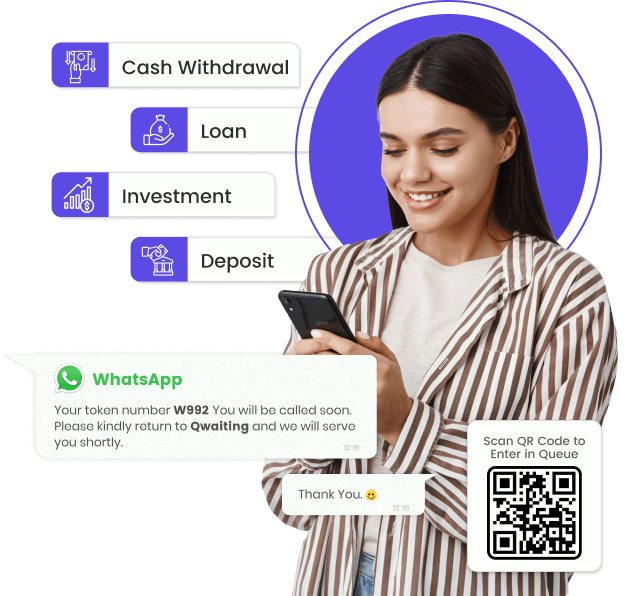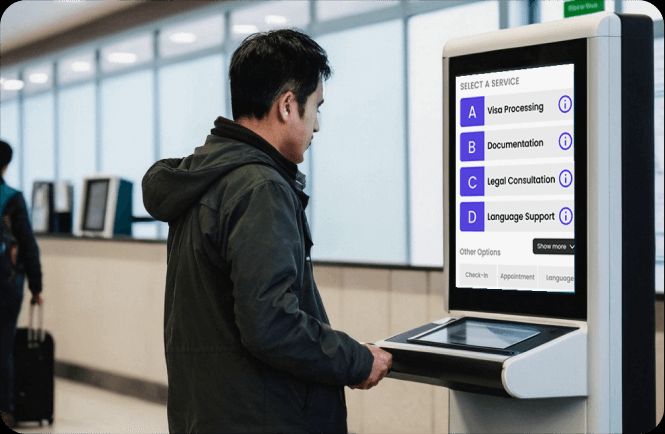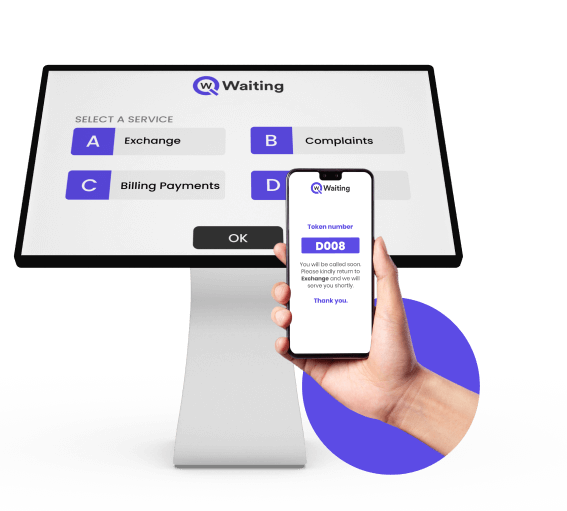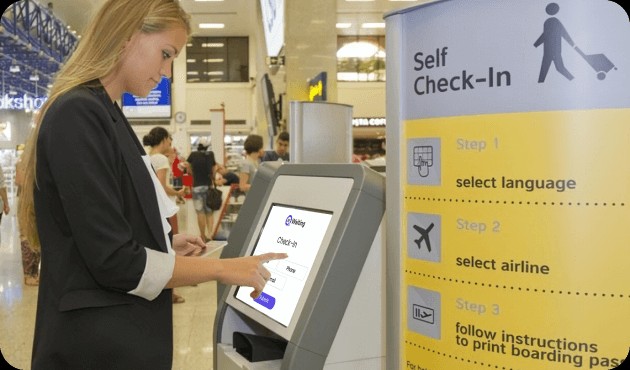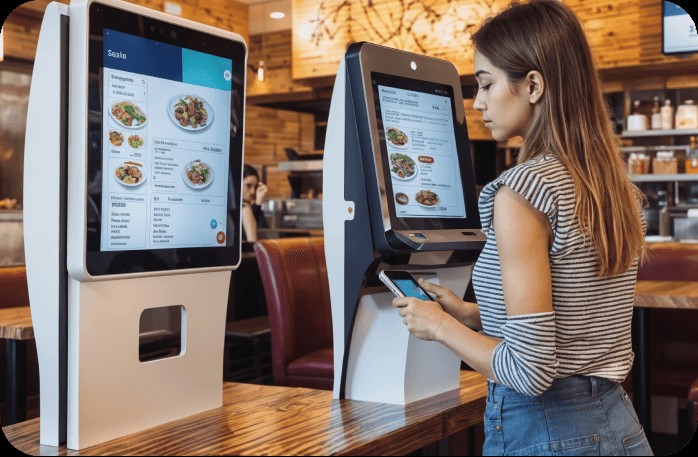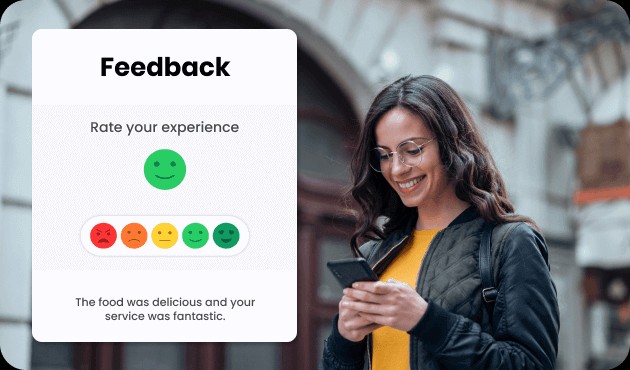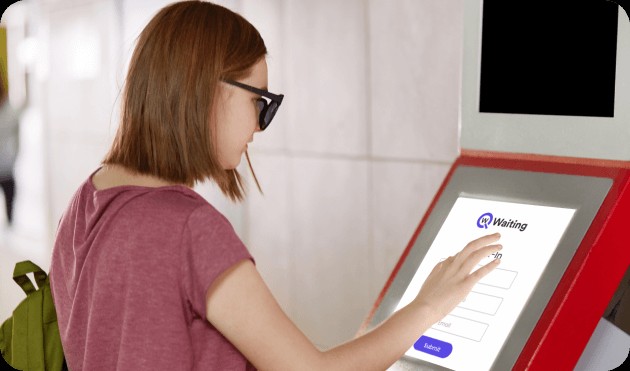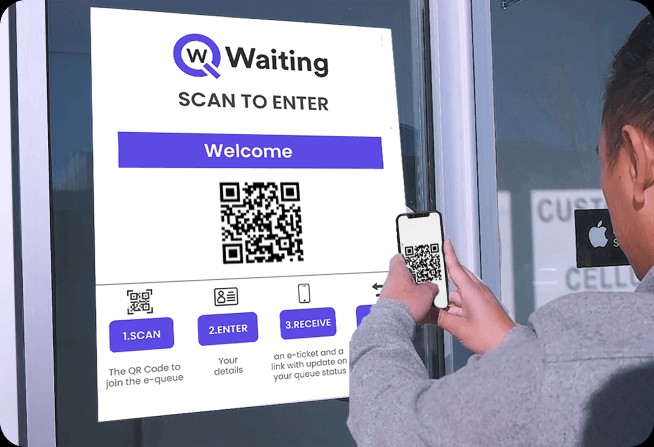
Imagine skipping the line and booking a movie ticket in seconds using a touchscreen kiosk. That’s the convenience your customers now expect and demand.
In fact, 66% of consumers prefer self-service over dealing with staff for routine tasks, according to PYMNTS.
From airports to hospitals and retail stores, self-service kiosks are transforming customer journeys. They simplify service, reduce wait times, and ensure consistent, efficient experiences.
In this blog, we explore how kiosks are reshaping key industries and how they can elevate your business, too.
Self-Service Kiosks: A Smart Choice for Any Business
When people walk into a shopping mall or a government office, you might have seen them using small digital touch screens that provide directional guidance or allow them to book services in advance, and save time. That’s a self-service kiosk, it looks simple, but it’s quietly changing how businesses work.
Here’s why kiosks are getting so popular and why businesses are adopting them:
Cut wait times by 50%
Box Technologies & Intel reports suggested that 86% of shoppers avoid stores with visible long lines. This affects your business’s revenue and reputation.
To ensure maximum sales, you can enhance customer satisfaction with interactive self-service kiosks. This way, your customers can use a kiosk machine to make quick check-ins, order, and pay in advance for what they need.
Reduce Staffing Costs by Up to 30%
McKinsey (2023) reports stated that by using a self-service kiosk for business, decision-makers can cut staffing costs by up to 30%.
Kiosks can automate manual tasks of registering and managing customer flow, saving your employees time, which helps them focus on upselling opportunities for providing exceptional customer service and increasing ROI.
Learn more about how businesses are replacing staff with self-service kiosks to improve efficiency.
24/7 service assistance
The kiosk will never tire out working throughout the day and night. It improves business operations, reduces the need for additional staff, and saves money.
How Self-Service Kiosks Are Solving Industry-Wide Problems
Self-service kiosks streamline routine tasks across industries, saving individuals time, reducing queues, and improving service.
Let’s look at the top 8 industries that benefit the most from using these kiosks.
Increased patient volume in hospitals has led to longer wait times and patient anxiety. Patients had to wait for 25+ minutes in a long line before consulting a doctor.
With the implementation of a kiosk, many hospitals and clinics observed improved work efficiency and staff members are able to serve more patients in less time.
Here’s how these smart queue management systems deliver real results:
1. Reducing Front Desk Load and Patient Anxiety
- Patients can enter their information and book appointments on their own, without help from staff.
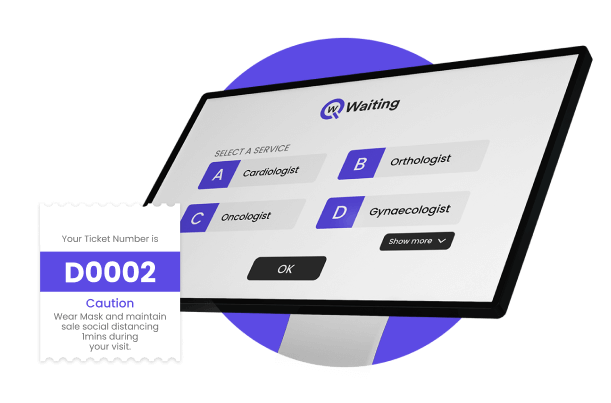
- Automatic alerts keep patients informed of their wait times and reduce reception area overcrowding.
2. HIPAA-Compliant, Secure Patient Interactions
- Any data leak can put the hospital administration in legal trouble. The privacy-first parameter ensures confidential check-ins.
- To register themselves, patients are required to fill out digital consent forms and e-signatures. This ensures better compliance and less paperwork.
3. Real-Time Integration with Hospital Information Systems (HIS)
- The kiosk machine can be easily integrated with existing business tools like EMRs, Plato, Elite Plus, etc, for accurate and updated patient records.

- The kiosks provide live queue status for patients and staff. This guarantees immediate consultation without any waiting time after check-in.
Example: “Holy Cross Hospital, USA, reduced its patient wait times to under 20 minutes per patient using an on-spot kiosk machine.”
The difficulties in managing long queues across several channels and requiring real-time data to make wise decisions are some of the major problems many banks face.
Bank kiosk systems help to automate daily operations and help customers avoid queuing. These kiosks ensure that banking is quicker, safer, and convenient for all the people who come in.
Kiosks are beneficial in banks because they help in:
1. Empower Customers with Self-Service
- Customers can easily update KYC or view account balances independently without any external help.
- The general public can print bank statements instantly, which reduces front desks’ workload, and staff members can focus on high-value services.
2. Secure, Encrypted Transaction Interfaces
- The kiosks are safe to use. They can only be accessed by authorized users, using their fingerprints or OTPs for safe access
- The kiosks use end-to-end 256-bit data encryption to avoid data theft.
3. Queue Management + Kiosks = Better Branch Traffic Control
- A kiosk can effortlessly handle both appointments and walk-ins without creating any confusion.
- A virtual queuing kiosk reduces crowding by sending people a notification on their phones when it’s their turn.
Fact: “Global Bank Kiosk Market Report (2025) claimed that banks using self-service kiosks reduced their transaction times by 40-60%”
We all know that government offices experience a citizen rush throughout the year. Whether it’s someone looking to renew their driving license or someone searching for counters to pay their electricity bills, a lack of proper guidance and excessive queuing can lead to delays and frustration.
Self-service kiosks can help people receive the services faster, reduce wait times, and make the service experience better by:
1. Managing Citizen Flow and Reducing Counter Visits
- Citizens can self-check in and book their services for different departments like DMV, taxes, or at immigration offices applying for visas using a touchscreen kiosk for government offices.
- The software automatically sends messages to phones right away when it’s someone’s turn. This keeps the office calm and organized.
2. Multilingual, ADA-Compliant Interfaces
- The kiosks support multiple languages, and their interface is very user-friendly, which ensures that they can be easily accessible by everyone.
- Kiosks can handle multiple users at the same time without crashing or slowing down. This ensures maximum operational efficiency and faster service delivery.
3. Transparent Service Process & Queue Visibility
- The kiosk screens display expected wait hours clearly and ensure fair visits to build public trust through visible transparency.
- Individuals can track their service progress and upload their important documents easily to remove any second thoughts.
Ever walked into a retail store and seen a long line at the checkout counter? Frustrating! Isn’t it? Statista reports revealed that 70% shoppers abandon their shopping carts if they experience long wait lines at checkout points.
Retailers use interactive kiosks to boost sales and encourage customer return visits to reduce wait times and earn maximum revenue. Here’s how self-service kiosk machines are benefiting retail stores:
1. For faster checkouts
- Shoppers can avoid standing in long lines at retail stores by using a POS kiosk, which allows them to browse, select, pay, and even initiate an exchange for their products all at once.
- Kiosk machines make checking out much faster because they let you pay in lots of different ways. This means fewer people leave without buying anything, and it makes them want to come back again.
2. Data-driven personalization
- A kiosk machine can save customer details and recommend related products by analyzing past shopping behavior. This creates higher opportunities for upselling and cross-selling, which results in more revenue.
- Kiosks can promote sales and offer deals, saving advertising and printing costs while driving customer engagement without staff involvement.
3. Upsell & Cross-Sell Opportunities
- A kiosk can suggest upgraded versions of products or sell a related or complementary product alongside the original purchase to customers, based on their past shopping experience.
- These opportunities promote impulse buys, and customers tend to purchase more if given great discounts.
Fact: “A US grocery store claimed that using self-service kiosks, they reduced shoppers’ transaction time to 18.7 seconds.”
-
Transportation Hubs (Bus Stands, Metro Stations, and Airports)
Transport centers use self-service kiosks to speed up passenger check-ins, remove any directional confusion, and keep travelers informed, making travel smoother and eliminating manual processes.
Here’s how ticketing kiosks are beneficial:
1. Self-check-in and boarding for passengers
- Using a kiosk system, passengers can reserve their tickets, pay for their preferred seats, and check in without standing in a long line to get a print ticket.
- Passengers can easily scan their tickets, get directional guides to speed up the passenger flow and avoid overcrowding at ticket counters.
2. Real-time updates and directional screens
- The kiosk, integrated with a real-time visitor flow software, can send personalized alerts to passengers, displaying their expected wait times. This helps reduce travel anxiety, and people can wait around conveniently until their travel.
- The large screens provide directional guides for travelers and help executive staff focus on their work and manage passenger flow.
3. Multimodal Integration: Ticketing, Baggage & Queuing
- A kiosk can be connected to a passenger’s smartphone, and using this, passengers can easily book, reschedule, or even cancel their bookings.
- The system can be easily integrated with existing queue systems and mobile apps to track the customer journey better.
Example: “Delhi railway station installed “Rail Yatri Guide” Kiosks in 2018, which guided the public to their assigned platforms and reduced confusion.”
Ever walked into a food joint and saw a big screen, people choosing their meals, paying quickly, and enjoying a smooth dining experience without waiting at the counter? Used by large food ventures to make ordering food faster and easier.
Here’s how restaurant self-order kiosks are beneficial:
1. Self-ordering for dine-in or takeaway
- People can order their food/drinks by tapping on a screen, which improves order accuracy and enables faster service delivery during peak hours.
- The kiosk generates a ticket, and customers can wait at their tables till their order gets prepared. This way, restaurants can take more orders and generate more profits.
2. Customize meals, reduce wrong orders
- Customers can choose their special personalizations on screens to avoid any miscommunication. This ensures maximum customer satisfaction.
- Personalized food orders help restaurants remove any food wastage, and they can curate their recipes, keeping customer preferences in mind.
3. Easy payment + Feedback collection
- At the time of checkout, customers can easily scan a QR code or add their card details to the kiosk to initiate a smooth payment process and claim loyalty rewards.
- The software then automatically sends a survey to the customer’s phone asking for food ratings or restaurant experience. This feedback can help owners improve or modify their services as per customer expectations for a better experience.
“Example: McDonald’s chain is among the first restaurants to adopt self-ordering kiosks at their outlets since 2018. After implementation, the customers’ wait times dropped by up to 30%.”
Schools and colleges are implementing self-service kiosks to automate tasks such as student sign-ups, staff appointments, and event check-ins. It helps save time and keeps campus visits organized.
Kiosks are important in modern schools and universities because they help by:
1. Printing student IDs and handling new registrations
- Existing students can fill out their semester forms, and new students can register themselves by adding their details and submit their fees with just a few steps.
- Automated student registrations save staff members time and avoid unnecessary paperwork. This lets executive staff focus on other tasks and maintain a calm work environment.
2. Appointment booking with staff or admin
- Students can set up their meetings with the university officials or guidance counselors using the kiosk in advance. This helps students avoid waiting and prevents last-minute cancellations.
- Using a central dashboard, staff members can send students tailored messages displaying their wait times and allocated meeting rooms.
3. Campus event check-ins + Feedback
- Students can add their participation and receive printed passes or digital tokens on their smartphones using a kiosk. This clearly shows how many students are coming to an event, which helps the people organizing it get ready beforehand.
- Students can leave their feedback about lectures or events using a kiosk form page. This feedback allows teachers and event organizers to tailor their approaches according to their students’ comfort.
Example: “The National University of Singapore (NUS) was facing issues with managing students’ appointments with the authorities. After installing a kiosk at the reception area, student wait times dropped by 40% and now they can book their appointments and pay their fees using a kiosk interface.”
-
Entertainment & Recreation
Ever booked your favorite movie ticket at the last minute, standing outside the auditorium? No? Well, now you can! Entertainment places are now using kiosks to speed up ticket booking, entry, and food orders. It helps visitors enjoy more and wait less, making the overall experience smooth.
Here’s how a ticketing kiosk at your movie theatre can benefit you:
1. To book tickets
- Using a touch-screen machine, people can easily get their movie tickets and their food, and pick their seats without going to a ticket window.
- This way, workers can easily handle tickets bought at the last minute and for too many people, making things go smoothly.
2. Self-entry at parks, gyms, museums
- Instead of maintaining paper logs, users can easily scan their QR/ Barcodes to gain entry into gyms or museums.
- This enables faster check-ins, eliminating unnecessary paperwork or the need to hire extra staff to oversee entries.
Fact: “Touch Dynamic study claims that movie theaters using a self-service kiosk for ticket/ seat selection, or ordering food, significantly cut wait times at food and service counters.”
The Future is Self-Service: Get Ready to Embrace It!
From busy hospitals, serving hundreds of patients daily, to luxury restaurants, self-service kiosks are gaining popularity because of their contribution, which helps industries reduce their customer wait times and boost their operational efficiency. They are no longer just “nice-to-have”, but a must-have across industries.
As more people use technology, businesses that put money into smart touch-screen machines will do better than others. These self-serve machines aren’t just a popular new thing; they are a lasting answer that saves money, makes people happier, and keeps your business running well.
Ready to future-proof your business?
Discover how Qwaiting’s self-service kiosks can transform your customer experience. Book a Free Demo Today and see the difference yourself!
FAQ’s
-
What is a self-service kiosk, and how does it improve customer service?
A self-service kiosk is a small digital touchscreen device that lets users check in, book, and make payments for their orders or services. These machines help customers avoid long wait lines by allowing them to check in virtually and speed up transactions.
-
Which industries benefit the most from self-service kiosks?
A kiosk is a multipurpose machine that can be used across various industries to manage customer flows and reduce long wait lines. Many such industries, receiving the most benefit out of a kiosk, are: healthcare, banking, airports, and government offices.
-
Are self-service kiosks secure for transactions and data sharing?
Yes, self-service kiosks like Qwaiting strictly follow all compliance rules and use AES-256 encryption, SSO protocols, and are GDPR/CCPA compliant to keep customer information safe. Only authorized users can access this data.
-
What accessibility features do kiosks offer for people with disabilities?
Self-service kiosks are ADA compliant, which means these kiosks support accessibility with voice assistance, screen magnifiers, height-adjustable touchscreens, and multi-language options, which everyone can easily access.
-
What are the payment options supported by self-service kiosks?
The kiosk supports multi-channel payment options to facilitate a smooth checkout experience for customers. Users can use their cards, UPI IDs, or even scan QR codes to process payments.
-
What if my retail team isn’t tech-savvy?
With user-friendly interfaces, guided workflows, and minimal training needs, even non-tech-savvy retail teams can operate them smoothly and serve customers faster.

